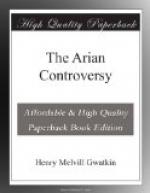Acacius had won his victory, and had now to pass sentence on his rivals. Next month a council was held at Constantinople. As the Semiarians of Asia were prudent enough to absent themselves, the Homoeans were dominant. Its first step was to re-issue the creed of Nice with a number of verbal changes. The anathemas of Phoebadius having served their purpose, were of course omitted. Next Aetius was degraded and anathematized for his impious and heretical writings, and as ’the author of all the scandals, troubles, and divisions.’ This was needed to satisfy Constantius; but as many as nine bishops were found to protest against it. They were given six months to reconsider the matter, and soon began to form communities of their own. Having cleared themselves from the charge of heresy by laying the foundation of a permanent schism, the Homoeans could proceed to the expulsion of the Semiarian leaders. As men who had signed the creed of Nice could not well be accused of heresy, they were deposed for various irregularities.
[Sidenote: The Homoean supremacy.]
The Homoean supremacy established at Constantinople was limited to the East. Violence was its only resource beyond the Alps; and violence was out of the question after the mutiny at Paris (Jan. 360) had made Julian master of Gaul. Now that he could act for himself, common sense as well as inclination forbade him to go on with the mischievous policy of Constantius. So there was no further question of Arian domination. Few bishops were committed to the losing side, and those few soon disappeared in the course of nature. Auxentius the Cappadocian, who held the see of Milan till 374, must have been one of the last survivors of the victors of Ariminum. In the East, however, the Homoean supremacy lasted nearly twenty years. No doubt it was an artificial power, resting partly on court intrigue, partly on the divisions of its enemies; yet there was a reason for its long duration. Eusebian conservatism was fairly worn out, but the Nicene doctrine had not yet replaced it. Men were tired of these philosophical word-battles, and ready to ask whether the difference between Nice and Nicaea was worth fighting about. The Homoean formula seemed reverent and safe, and its bitterest enemies could hardly call it false. When even the court preached peace and charity, the sermon was not likely to want an audience.
[Sidenote: The Homoean policy.]
The Homoeans were at first less hostile to the Nicene faith than the Eusebians had been. After sacrificing Aetius and exiling the Semiarians, they could hardly do without Nicene support. Thus their appointments were often made from the quieter men of Nicene leanings. If we have to set on the other side the enthronement of Eudoxius at Constantinople and the choice of Eunomius the Anomoean for the see of Cyzicus, we can only say that the Homoean party was composed of very discordant elements.
[Sidenote: Appointment of Meletius.]




